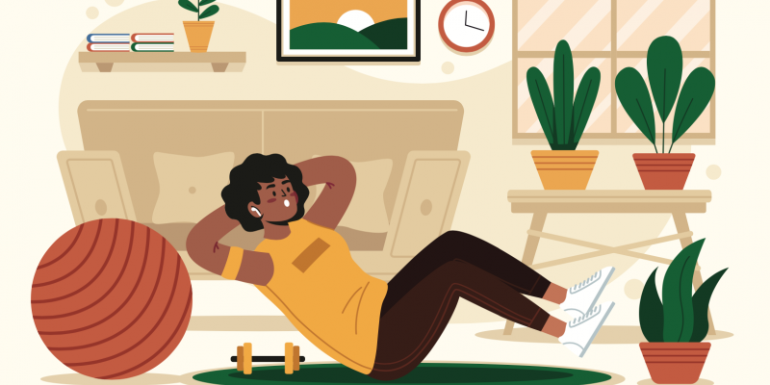Miles from the gym? No problem — experience the benefits of exercise in the comfort of your home.
By Shelby Deering
If you’re accustomed to sweating it out on a treadmill or attending an exercise class with friends, your workout schedule might look a little different these days. Whether your gym continues to be closed due to COVID-19, its hours and classes are limited or perhaps you’re not feeling quite ready to join your fellow fitness enthusiasts, you can take comfort in the fact that you can still achieve a high-quality workout right in your own home.
Even if your desire to work out at home isn’t related to the pandemic — maybe you’d just prefer to skip driving to the gym in inclement winter weather — you can still feel the burn without getting in the car.
“No matter the space, equipment or time you have, you can still get a good workout in,” says Emily Thielsen, fitness director of Geneva Lakes Family YMCA.
THE BENEFITS OF HOME WORKOUTS
There is one major similarity between home workouts and gym workouts — they share the same brain and body benefits.
If you’re experiencing more stress than usual these days (And let’s be honest, who isn’t?), getting in a workout at home can be extremely helpful.
“Exercise, in my opinion, is probably the best way to combat stress,” says Joe Schiessl, director of sports performance at Elkhorn’s GTS Performance and Fitness. “A lot of things happen in the brain during and after exercise. In relation to combating stress, a number of endorphins are released that can regulate mood for the better.”
It’s also a way to ease Seasonal Affective Disorder (SAD), a type of depression that takes place during the winter due to less sunlight and a disruption in one’s circadian rhythm. Whether you’re dealing with SAD or a touch of the winter blues, Schiessl says that exercise releases good brain chemicals that improve mood. “Depression is all about brain chemistry, and our environment can affect this,” he adds.
GETTING SET UP
If you’ve been on the fence about working out at home, perhaps these benefits have convinced you that you don’t necessarily need to head to the gym to accomplish a quality workout. In fact, by getting creative with your space and purchasing a few pieces of equipment, you can create your own home gym in no time.
“It’s surprisingly easy because you only need as much space as your movement will take up,” explains Laura Hotopp, fitness director of the Aurora Wellness Center in Burlington. She says that it’s as simple as finding a space that’s “big enough for your legs and arms to extend in all directions,” which is good news for those who live in small homes or apartments.
Thielsen says that a basement or garage can certainly double as a home gym. “Those two spaces typically have concrete flooring and will be able to safely support all the equipment as well as all the jumping or moving you will do.”
Although, Schiessl adds that if you’re only looking to do straightforward bodyweight exercises without sizable equipment, such as a treadmill, a 6-by-6-foot space will absolutely suffice. This means that a diminutive bedroom or living room could act as your workout studio.
When it comes to equipment, what you choose, Hotopp says, depends on the type of workout you’d like to do.
“If you want to strength train, you’ll need some weights,” she says. And even if you don’t have weights on hand, she lists plenty of at-home alternatives, adding, “If you don’t have weights, you can use water bottles or canned goods, milk jugs filled with water or even a small backpack or purse filled with anything to weigh it down. A bag of flour can be a substitute for a kettlebell.”
Thielsen recommends purchasing a mat, and if you want to focus on strength training, you can buy a couple sets of dumbbells, a bench and an Olympic bar, which will allow you to bench press along with other simple lifts. If you’re aiming for balance and flexibility, she advises looking to stability balls, yoga blocks, straps and a BOSU ball as essentials.
Maybe you’re leaning toward skipping equipment altogether, at least until you get the hang of working out at home. In this case, Hotopp suggests bodyweight exercises, which use the weight of your own body to provide resistance against gravity, or cardio workouts, either of which can be done without equipment.
GO VIRTUAL
During the pandemic, more and more exercise enthusiasts have turned to virtual classes to get their sweat on. This is a great option if you’re used to having an instructor lead your workouts.
“There are a lot of virtual classes available to stream, so you don’t have to miss out on your favorite classes,” Thielsen says, noting that Geneva Lakes Family YMCA offers quite a few virtual classes. “If there is a specific class that you are missing, call your local fitness club and see if you can join the class virtually,” she suggests.
Many fitness classes are offered through Zoom or Facebook Live. As Schiessl notes, “Typically, they keep the same energy in the workouts even though they are virtual. It’s just a matter of finding the right fit for you and what you like.”
CHALLENGE YOURSELF
Although many bodyweight workouts, such as Yoga, Zumba, Pilates and High Intensity Interval Training (HIIT), are available virtually through classes or personal trainers, there are dozens of other exercises in this category that are ideal for small spaces.
“The bodyweight workout uses the weight of your own body and it can be surprisingly effective,” Hotopp observes. “Bodyweight exercise can work nearly every muscle in your body.” She recommends some tried- and-true bodyweight moves, like push- ups, planks, squats, crunches, glute bridges and lunges.
To get your heart pumping, Hotopp adds, you can incorporate some cardio into the bodyweight moves. “You can choose to ramp up the intensity if you’re looking for cardio. For example, instead of holding a plank, you can step or run some mountain climbers to get that heart rate up. Jacks, burpees and lunges are examples of bodyweight exercises that can be performed at high speed or moderate speed.”
If it’s muscle you’re after, Schiessl says that you can always add dumbbells to these classic bodyweight exercises.
Another factor to consider for your at- home workouts is how much time you want to devote to exercising. “I would say that the easiest exercises for people to do at home are the workouts that require the least amount of equipment or are under an hour in time,” Thielsen says. “Sometimes, with workouts that require or advise the use of specific equipment, it can then take more time out of your day to set up and rearrange your space in your home.”
If you’d like to take in some scenery beyond your living room, remember that you can always head outdoors for your workouts, something that can alleviate winter depression. “Outdoor exercises are always a great option,” Hotopp says. “Walking, running and bicycling are examples. Exercise comes in all shapes and forms, so give yourself credit for getting up and moving in any capacity.”





